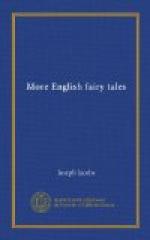Parallels.—Miss Cox’s admirable volume of variants of Cinderella also contains seventy-three variants of Catskin, besides thirteen “indeterminate” ones which approximate to that type. Of these eighty-six, five exist in the British Isles, two chap-books given in Halliwell and in Dixon’s Songs of English Peasantry, two by Campbell, Nos. xiv. and xiv_a_, “The King who Wished to Marry his Daughter,” and one by Kennedy’s Fireside Stories, “The Princess in the Catskins.” Goldsmith knew the story by the name of “Catskin,” as he refers to it in the Vicar. There is a fragment from Cornwall in Folk-Lore, i., App. p. 149.
Remarks.—Catskin, or the Wandering Gentlewomen, now exists in English only in two chap-book ballads. But Chambers’s first variant of Rashie Coat begins with the Catskin formula in a euphemised form. The full formula may be said to run in abbreviated form—Death-bed promise—Deceased wife’s resemblance marriage test—Unnatural father (desiring to marry his own daughter)—Helpful animal—Counter tasks—Magic dresses—Heroine flight—Heroine disguise—Menial heroine—Meeting-place—Token objects named—Threefold flight—Lovesick prince—Recognition ring—Happy marriage. Of these the chap-book versions contain scarcely anything of the opening motifs. Yet they existed in England, for Miss Isabella Barclay, in a variant which Miss Cox has overlooked (Folk-Lore, i., l.c.), remembers having heard the Unnatural Father incident from a Cornish servant-girl. Campbell’s two versions also contain the incident, from which one of them receives its name. One wonders in what form Mr. Burchell knew Catskin, for “he gave the [Primrose] children the Buck of Beverland,[3] with the history of Patient Grissel, the adventures of Catskin and the Fair Rosamond’s Bower” (Vicar of Wakefield, 1766, c. vi.). Pity that “Goldy” did not tell the story himself, as he had probably heard it in Ireland, where Kennedy gives a poor version in his Fireside Stories.
Yet, imperfect as the chap-book versions are, they yet retain not a few archaic touches. It is clear from them, at any rate, that the Heroine was at one time transformed into a Cat. For when the basin of water is thrown in her face she “shakes her ears” just as a cat would. Again, before putting on her magic dresses she bathes in a pellucid pool. Now, Professor Child has pointed out in his notes on Tamlane and elsewhere (English and Scotch Ballads, i., 338; ii., 505; iii., 505) that dipping into water or milk is necessary before transformation can take place. It is clear, therefore, that Catskin was originally transformed into an animal by the spirit of her mother, also transformed into an animal.
If I understand Mr. Nutt rightly (Folk-Lore, iv, 135, seq.), he is inclined to think, from the evidence of the hero-tales which have the unsavoury motif of the Unnatural Father, that the original home of the story was England, where most of the hero-tales locate the incident. I would merely remark on this that there are only very slight traces of the story in these islands nowadays, while it abounds in Italy, which possesses one almost perfect version of the formula (Miss Cox, No. 142, from Sardinia).




